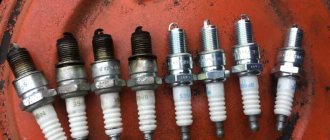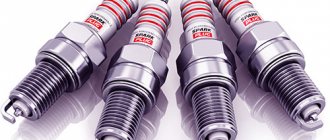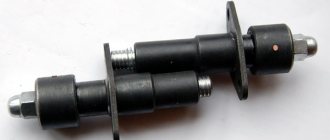Many car enthusiasts are well aware that the ease of starting, power, efficiency and stability of the engine in different modes depends on the quality and efficiency of combustion of the working fuel-air mixture. The spark plugs are responsible for igniting the mixture directly in the combustion chamber.
These parts produce an electric spark to ignite the fuel charge. Moreover, in some cases, elements are considered to be so-called “consumables” with a limited service life. Today, products from various manufacturers are available for sale; each manufacturer claims a certain service life for their products, that is, after how many km. change spark plugs.
As a rule, for various types of internal combustion engines, such products can be conventional or with an extended service life. Based on the manufacturer’s specific data, you can clearly understand how long it takes to change different types of spark plugs. However, despite all the apparent simplicity, in practice the situation is somewhat different.
In this article we will look at when to change spark plugs and how often to change spark plugs, how to understand when it is time to change spark plugs. We will also answer frequently asked questions about how long spark plugs last and what affects their service life, how to replace spark plugs correctly and whether it is possible to change spark plugs one at a time, how much it costs to replace spark plugs, why change spark plugs if the old ones work, etc.
What are spark plugs for?
— A spark plug in a car is a device for igniting the fuel-air mixture in heat engines. In simple terms, this is what gives the spark for the engine to work,” explains car mechanic and owner of an auto parts store Nikolai Voronin . — Without candles, the machine cannot work.
The engine starts when the air-fuel mixture ignites due to a spark formed between the spark plug electrodes. There will be no spark without spark plugs, which means that spark plugs can safely be called the heart of the engine; a lot depends on them.
Guess which spark plug is faulty
It's not uncommon for an engine to feel like it's stumbling or just running, but all of the spark plugs appear fine and even free of carbon deposits. What to do in such a situation if we do not want to change the entire set at once?
Just disconnect each plug in turn from the wiring and observe the behavior of the motor, take it into account. The source of the problems is the spark plug, which does not change the engine's performance.
True, the cause of engine malfunction is not always the spark plug. Instead, after the replacement, you will realize that the problem is definitely not traffic jams.
Where are the spark plugs located?
Engine 8-valve
In these engines, the spark plugs are screwed into the side and go into the cylinders. All four spark plugs have armor wires - they give a spark to the spark plug, and the engine starts.
Engine 16-valve
Compared to an 8-valve engine, a 16-valve engine has spark plugs screwed into the cylinders and they are located not at the side, but at a right angle. There is also one more difference - in this engine there are four separate ignition modules for the spark plugs, while on the 8-valve engine there is one large one.
show more
Reasons for their natural and premature wear
The spark plug operates under extremely extreme conditions:
- high temperature in the working cylinder;
- aggressive environment in the form of a mixture of fuel, air and oil;
- high pressure during ignition;
- high voltage and temperature of electric spark.
The simultaneous action of these factors leads to an intensification of the processes of their natural wear. This process can be significantly accelerated in the following cases:
- reduction of compression, wear of valve stem seals due to oil entering the working volume;
- incorrect setting of the ignition angle, leading to the formation of increased carbon deposits;
- choosing spark plugs that do not match the engine brand;
- misfire in cylinders;
- incorrect gasoline/air ratio due to malfunctions of the flow meter, lambda probe, or air leaks;
- incorrect operation of injectors.
How to check spark plugs for functionality
When the car starts to “trouble” or run unevenly, before going to a car service, motorists look under the hood to assess the condition of the spark plugs. There are several methods to check spark plugs for functionality.
We remove the wires from the spark plugs one by one with the engine running.
This must be done very carefully; the car must be started. We remove the wires from the spark plugs one at a time and listen carefully to the noise of the engine. If, after you removed the wire, the motor does not change its operating sound, then this spark plug is faulty. Most likely, a failed spark plug will have to be replaced, but sometimes it’s enough to just clean it.
Checking the spark plugs with a pistol
Car dealerships sell a special “gun” for checking spark plugs yourself. We insert the spark plug into the special hole and see if there is a spark. If it is not there, then the spark plug needs to be replaced.
Replacement sequence
Despite its apparent simplicity, this operation should be taken responsibly. Replacement should be made as a complete set (!)
. Partial replacement of one or two “lost” spark plugs is only possible for a short time.
Different gaps and types of spark plugs and their conditions lead to inevitable failure of ignition timing, increased detonation, and contribute to increased engine wear.
The selection of spark plugs should be made for the vehicle based on reference data. You shouldn’t rely on “these are the best” recommendations. It is better to purchase products only from trusted manufacturers.
As the main tool for replacing spark plugs, it is better to use a special long head with rubber inserts to grip the spark plug being removed. Before purchasing it, you should measure the diameter of the mounting hole.
The standard sizes of spark plug heads are 16 and 21. The length of the seating zone can be different, up to 180 millimeters in certain engine models. In some cases, you can use a spark plug tube, but keep in mind that its reliability is less. It’s even worse to use special keys from unknown manufacturers in beautiful packaging. They may break the first time you unscrew them.
Sequence of spark plug removal:
- remove the installed high-voltage wires, having previously noted or photographed the sequence of their installation;
- if the car has individual ignition coils or a coil block installed in the spark plug space, dismantle them (in V-shaped engines this process can be complicated by the need to dismantle part of the intake manifold and other engine elements);
- be sure to check the spark plug installation areas for the presence of foreign objects (when removing the spark plug, fragments of insulation and other objects may fall directly into the cylinder and cause big problems);
- securely install the spark plug wrench, apply medium force, and begin unscrewing;
- if the dismantling process is difficult, it is necessary to use special means for decoking the threaded connections, and do not try to apply excessive force;
- remove the spark plug (if the retaining rubber band has come off, you can do this using the tip of a high-voltage wire);
- It is better to install a plug or throw a clean rag on the vacated spark plug hole (there are many cases when, during the repair process, nuts, washers and other “surprises” get there, that is, into the cylinder).
Video - replacing spark plugs for Renault Logan and Largus (8 valves):
New ones are installed according to the following rules:
- first, use a clean rag to clean the installation area from oils and dirt (if this place is inaccessible for visual inspection, it is better not to do this: trying to remove contamination from above the threaded connection, you can redirect it to the thread);
- when installing new ones, you must once again check that the seating depth of the spark plug matches the old one;
- The initial direction of the spark plug into the seat is done carefully using a spark plug wrench; you should not “throw” the spark plug, this may change the gap;
- preliminary tightening should be done with a slight force; if movement is difficult, you need to unscrew and start tightening the spark plug again;
- the final “squeezing” of the spark plug is done with medium force (at service stations, a torque wrench is used for this; the tightening torque is set in the range from 15 to 35 Nm, depending on the thread diameter and type of fit);
- The last stage of installation of spark plugs is the installation of high-voltage wires.
How often do you need to change spark plugs?
The expert advises not to blindly believe the regulations - in this matter, everything is individual. In general, it is ideal to replace old spark plugs with new ones every 30,000 km. But, if the spark plugs still work properly without causing problems for your car, what's the point? Just a waste of money. Some spark plugs can last 60,000, 120,000 km, and even more. Just check the spark plugs every 30,000 km and, of course, if you notice that the car is running rough.
“On “charged” engines (sports, racing cars), if you don’t change the spark plugs for a long time, you can say goodbye to the engine, because the spark plug insulator tends to break off and fly into the cylinder,” says Nikolai Voronin .
Why change working spark plugs?
If well cared for, power supplies can last over 10 years, but all items have an expiration date on them that must be taken into account. Old devices, even if they do not show wear, can lead to damage to motor parts. Should be considered:
- Changing the gap between the electrodes negatively affects the ignition timing.
- Misfire leads to detonation and wear of engine parts.
- Dirty spark plugs can damage the ignition coil.
- Incorrectly functioning elements affect the environmental parameters of the power unit.
The worst problem that can arise with old CBs is contamination of the threaded connection, which can result in thread failure, which will entail the need to replace the BC.
How to replace spark plugs
— In fact, spark plugs are very easy to replace. But it’s still better to stick to the algorithm, especially if you’re changing spark plugs for the first time, the expert continues:
- It is necessary to remove the protective casing from the engine and other elements that interfere with access to the spark plugs.
- The second step is to remove any dirt around the candle. This can be done using a compressor or brush. This dirt must not get into the spark plug well.
- You need to grab the wire cap with your hand as close to the motor as possible, and then gently pull it towards you to remove the terminal from the spark plug. Do not pull sharply so as not to damage the wires or cap.
- Prepare a socket wrench with an extension and a spark plug head in advance. With its help you will need to unscrew the spark plug. Immediately put a new one in its place, do the same with the rest of the spark plugs and connect the wires so as not to get tangled. Be careful not to twist the spark plugs!
- Connect the terminal to the spark plug.
- Replace all previously removed protective elements and the protective casing.
Signs of wear
The following factors may indicate a malfunction of the SZ:
- reduction in engine power;
- increased fuel consumption;
- engine tripping;
- problems starting the engine.
All problems are related to sparking of the spark plug. It is necessary to diagnose and promptly replace damaged elements with new ones.
Gap Study
An important detail of the SZ is the correctly set gap between the electrodes. During vehicle operation, the contact materials wear out and the gap increases. As a result, sparking is disrupted, breakdown voltage increases, and fuel consumption increases.
When preparing your car for winter, you must check and adjust the gap between the electrodes using a round feeler gauge, taking into account the required dimensions.
Presence of soot
When inspecting spark plugs, you first need to pay attention to carbon deposits, which are conductors and create current leakage. Over time, the deposit increases, the voltage between the electrodes disappears, and the part stops functioning.
The gray-yellow or light brown color of the carbon deposits does not affect the operation of the engine and does not need to be cleaned. It is not advisable to unnecessarily leave scratches on the electrodes, because... they contribute to the accumulation of soot. If the carbon deposits are black, the candle must be placed in a prepared container with gasoline or solvent and held for 30 minutes. Then use a wire brush to clean off the carbon deposits. After this procedure, the device must be thoroughly dried.
Ceramic insulator
The SZ insulator is made of aluminum oxide ceramics, which can withstand temperatures of 450-1000 ° C. The part adjacent to the electrode greatly affects the quality of the element’s operation.
Black or brown deposits on the insulator of the part indicate a breakdown of the exhaust gases or a malfunction of the high-voltage wires.
Signs of spark plug wear
A visual inspection after dismantling the igniter will help to draw the right conclusions; the permissible size of the electrode gap is always indicated on the body of the device, the last number will indicate the required millimeters. If significant deviations appear after measurements, such a sample should not be on the car. Soot will tell you that the mileage of the igniter is already quite long, because according to the idea, the element should self-clean while driving. People who clearly understand how many kilometers they need to change spark plugs can avoid even such manifestations. When looking at the condition of a ceramic insulator, you should look for the presence of microcracks and brown deposits; the formation of cobwebs is considered a serious drawback.
Consequences of neglect
If the car owner does not replace the batteries in a timely manner, the consequences may be mechanical damage to parts of the power unit or failure of the ignition system. The engine will stop starting, and an expensive overhaul of the power unit will be required.
For normal engine operation, it is necessary to replace the spark plugs exactly at the time specified by the manufacturer, even if they do not look worn out. Power supplies should be diagnosed regularly - every 10,000 km.
Normal condition of spark plugs
The thermal cone of the insulator is between gray-white, gray-yellow and light brown.
The engine is ok. The correct heat number has been selected. The mixture control and ignition settings are correct. No misfires
, the cold start device is functioning. The engine oil does not contain lead deposits from fuel additives or alloying components. There is no thermal overload.
Candles are covered with soot
The heat cone, spark plug body and electrodes are coated in silky matte black soot.
Cause:
Incorrect regulation of the mixture composition (carburetor, fuel injection system).
The mixture is too rich, the air filter is clogged
, the device for enriching the mixture when starting the engine is faulty or there was starter draft (carburetor air damper), frequent trips over short distances, the spark plug is too cold, the heat rating is too low.
Consequences:
Missing spark formation, poor starting quality.
Remedy:
Correctly adjust the mixture composition and starting device, check the air filter.
Oily car spark plugs
The heat cone, spark plug body and electrodes are covered with oil deposits or shiny soot.
Cause:
There is too much oil in the chamber. Piston rings, cylinders and valve guides are too worn.
Consequences:
Missing sparks, poor starting quality.
Remedy:
Repair the engine, fill in the correct fuel-oil mixture, change the spark plugs.
Ferrocene on auto-candle
Ferrocene is a metallic compound, orange in color. The cone, electrodes and body of the spark plug are sometimes covered with orange adhering deposits - this is ferrocene.
Cause:
Some fuel additives may contain iron. During normal operation, deposits form after just a few thousand kilometers.
Consequences:
The iron coating conducts current and misfires occur.
Remedy:
The spark plugs need to be replaced.
Lead deposits on the spark plug
On the thermal body there is a yellow-brown glaze in places, which can sometimes turn into a greenish color - this is lead deposits on the auto-candle.
Cause:
Fuel additives contain lead. Plaque occurs at very high engine loads after prolonged operation at partial load.
Consequences:
At high loads, the coating becomes a current conductor, causing missed sparking.
Remedy:
Change spark plugs. There is no point in cleaning the spark plug.
Ash formation on a candle
A deposit of ash, which appears from additives to oil and fuel. It is formed on the thermal cone of the insulator, in the cavity of the working mixture (annular gap), and on the side electrode.
Cause:
Alloying components, primarily oil, sometimes leave this ash in the combustion chamber and on the insulator's heat cone.
Consequences:
Glow ignition with loss of power and engine breakdown.
Remedy:
Engine repair; replacing spark plugs; Possibly adding a different oil.
Wear or melting of spark plug electrodes
Melting of the central electrode of an auto-candle
Melted central electrode, softened tip of the thermal cone of the insulator.
Cause:
Thermal overload due to too early ignition, residual fuel in the combustion chamber, faulty valves, broken ignition timing and poor fuel quality. Probably the heat rating is too low.
Consequences:
Misfire, loss of power, engine failure.
Remedy:
Check the engine, ignition and mixture preparation system. Install new spark plugs with the correct heat rating.
Severe wear on the central electrode of the spark plug
The candle looks worn, shabby with elements of deformation.
Cause:
The spark plugs haven't been changed for a long time.
Consequences:
Skipping the creation of a spark, often during acceleration, due to the fact that the voltage is no longer enough for a large gap between the electrodes.
Remedy:
Replace spark plugs.
Factors that shorten spark plug life
There are a number of factors affecting the operation of power supplies:
- Fuel-air mixture. A lean mixture contributes to early ignition and fuel detonation, which leads to mechanical damage to the engine. A rich mixture provokes the appearance of black carbon deposits on the electrodes of the spark plug and further failure of the part.
- Compression. High or low compression in the cylinders creates temperature differences in the combustion chamber, as a result of which the cylinders operate unstably and burn out over time.
- Incorrectly set ignition affects the duration of operation of the elements.
- Too low a temperature causes the air-fuel mixture to become lean.
- Air humidity reduces the compression of the power unit.
Therefore, it is necessary to periodically diagnose the engine and ignition system.











